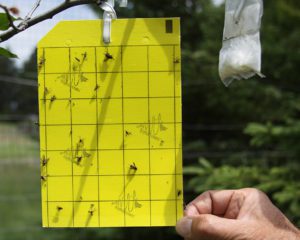Cherry Fruit Flies, Western
Latin name: Rhagoletis indifferens Curran
Size: Fly is about 1/5″ long
Color: Black body, transparent wings with black bands
Life cycle: The adult emerges from the soil in May, about 5 weeks before the cherries will be ready to harvest. When the cherries start turning yellow, the flies mate. The females deposit their eggs underneath the skin of the developing cherries. The larvae hatch and burrow toward the cherry pit. Two to three weeks later, they emerge from the fruit, fall to the ground and pupate in the soil. As there is only one generation of offspring per year, they will emerge as adults the following spring.
Signs of their activity: Holes in the cherries, worms inside the cherries (yuck). Only the larvae damage the cherries.
Typically seen on: Cherry trees
Controls: Use cherry fruit fly traps (these are sticky yellow traps, of the same yellow color as the developing cherries that the flies are attracted to and lay their eggs on). At the first sign of flies on the trap, use a spray containing the organic control Spinosad. ALWAY follow the label directions on sprays and other commercial products! Do not spray Spinosad near areas where bees are active as it will kill them.
Cultural practices: Clean up any cherries that have dropped to the ground. Dispose of (do not compost) any damaged cherries.
Natural predators: There are parasitic wasps that prey on the cherry fruit fly larvae.
Additional information: Washington State University’s Western Cherry Fruit Fly, University of Utah’s Western Cherry Fruit Fly.
Back to Organic Pest Control

